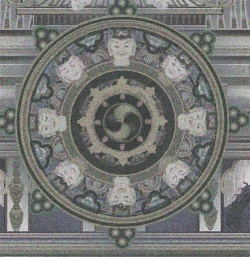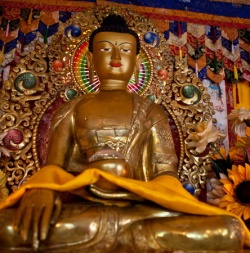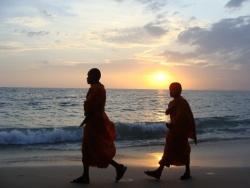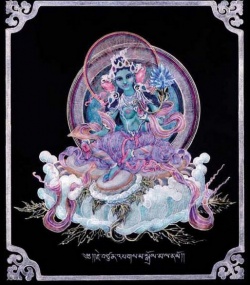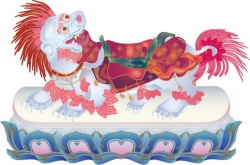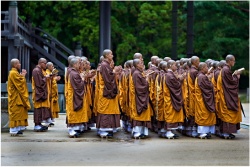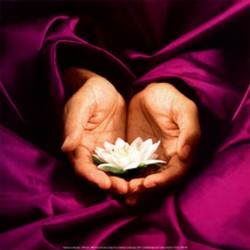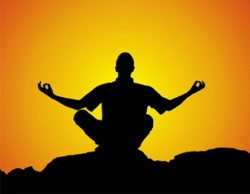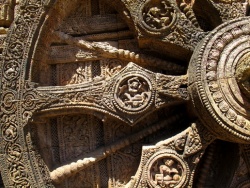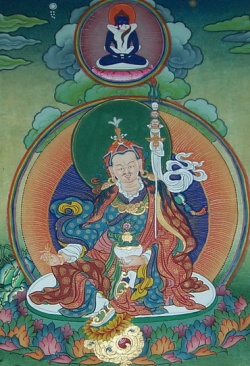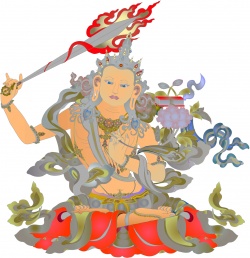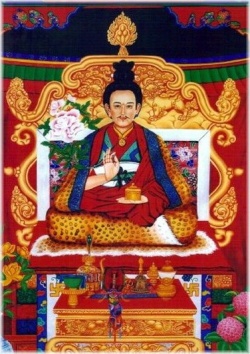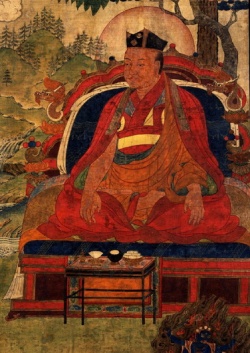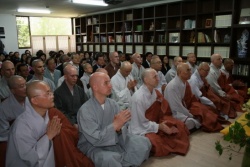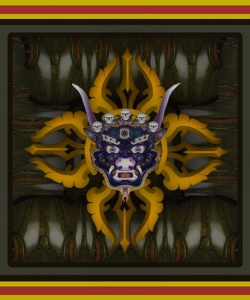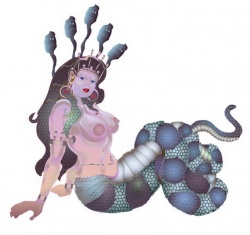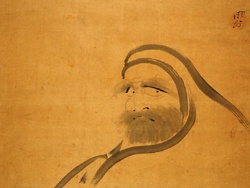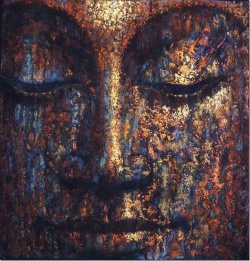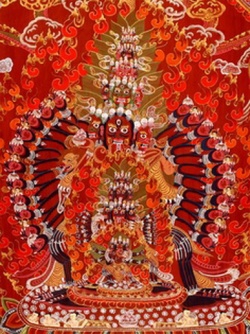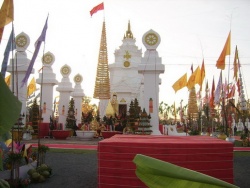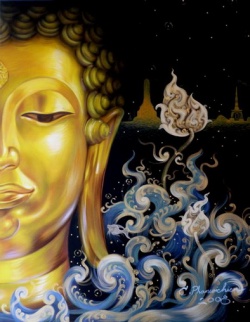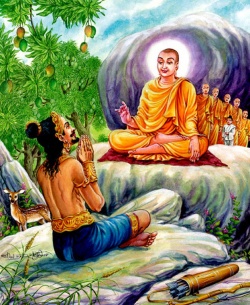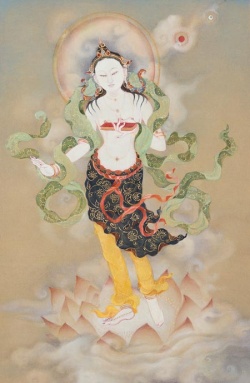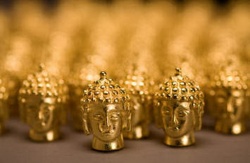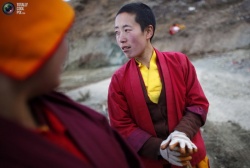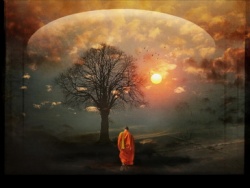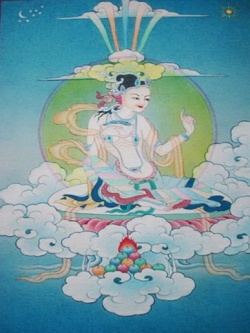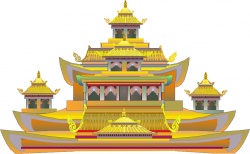The Early Buddhist Ideal Of The Monk
Buddha, who discovered the path to enlightenment after a successful process of trial and elimination, proclaims a new way of religious life which he recommends to his followers under the name of brahmacariya.1
We find that as the goal of this life of brahmacariya the accent falls on the release from dukkha2 and the attainment of nibbāna.
This is clear from the recurring statement in the texts which is ascribed to the Buddha:
'Come. O monk, live the life of brahmacariya in order that you may make an end of suffering '
(Ehi bhikkhu ' ti bhagavā avoca svākkhāto dhammo cara brahmacariyam sammā dukkhassa antakiriyāyā ' ti
- Vin.I.12.).3
This orientation is due to the fact that the Bodhisatta's search for enlightenment derived its urge from his consuming anxiety to discover the root-cause of the phenomenon of dukkha and the way to its extinction.4
The Bodhisatta seems to have analysed the problem of dukkha in terms of its origin (samudaya) and its cessation (nirodha).5
Through this, it is not difficult to see the emergence of the Noble Truths or Ariya-saccāni as a part of the basic doctrines of Buddhism. This quest of the Bodhisatta resulted in the discovery of the ultimate cause of dukkha and hence of its cessation too, a discovery which he made following the principle of causal genesis
(idappaccayatā paṭicca-samuppādo).
From this, the evolution of the Chain of Causation would have naturally resulted. In the Sammādiṭṭhi Sutta,6 the venerable Sāriputta defines dukkha and analyses it in terms of its origin, cessation and the path leading to its cessation. Thereafter, he defines likewise the twelve links of the Paṭiccasamuppāda chain and analyses each one of them in turn in the same manner. In this analysis of Sāriputta we see an extended use of the Buddha's idea of causal genesis. Here too the successive links of the chain follow, as it were, from an analysis of dukkha.
Thus it is clear that the fact of dukkha was the starting-point of the Bodhisatta's journey of discovery of the causative links. As Buddha, he makes this point crystal clear in more than one place. Thus he tells the venerable Anurādha:
'One thing do I teach, suffering and the cessation of suffering'
(Sādhu sādhu anurādha pubbe cā ' ham anurādha etarahi ca dukkhañ c' eva paññāpemi dukkhassa ca nirodhan ' ti
- S.IV. 384. See also M.I.140.).
Nothing could have been a more realistic approach to moksha or deliverance than an awareness of the presence of suffering and a desire to terminate it. Even in his first sermon to the Pañcavaggiya monks,7 the Buddha discoursed on dukkha and the escape therefrom. This is so fundamentally the dominant theme of Buddhism that even the philosophical expositions of nibbāna savour of this. They describe nibbāna as being the termination of dukkha:
es'ev' anto dukkhassa.
(Atthi bhikkhave tadāyatanam yattha n ' eva pathavi na āpo... es ' ev ' anto dukkhassā ' ti ... etc.
- Ud. 80f.)
This current life, associated together with the idea of many more repeated existences, appeared to the Bodhisatta as but a single link in the continuous chain of births and deaths, holding between them decay and disease as inescapable consequences. These ills of life, which the Bodhisatta observed around him, stand out as the first promptings which stirred him to the quest of a way of release from them.8
The inquiry which he initiated and the results he achieved have become so significant in the history of Buddhism that these researches have been referred retrospectively to times anterior to Buddha Gotama.9
They are ascribed to all the six Buddhas of the past who are listed together in the Mahāpadāna Sutta.10
All these Buddhas seem to make the same observation regarding life in the world, namely, that the world is subject to the ills of birth, decay and death with the threatening reality of birth again in another existence.
'And to me, brethren, before I was enlightened, while I was yet unenlightened and Bodhisatta, there came this thought: Alas! this world has fallen upon trouble. There is getting born and decaying and dying and passing away and being reborn. And yet from this suffering, from decay and death, an escape is not known.
O when shall escape from this suffering, from decay and death, be revealed? Then to me, brethren, came this thought, What now being present, does decay and death come to be? What conditions decay and death? ' 11
The theory of causal genesis in Buddhism was therefore a direct outcome of this probe and it is little wonder that the venerable Assaji. who was one of the first five disciples of the Buddha, gave this theory as the essence of his master's teaching :
Ye dhammā hetuppabhavā tesam hetu tathāgato āha
tesañ ca yo nirodho evamvādi mahāsamano ' ti.12
In the Ariyapariyesana Sutta, the Buddha himself identifies the theory of causal genesis - idappacayatā paṭiccasamuppādo, a theory in terms of which phenomenal existence and all its concomitants are explained, as the central feature of his Dhamma. As the only complement to this the Sutta introduces the cessation of samsaric existence which is the goal in Buddhism - nirodho nibbānam.13
The words of Assaji are undoutedly resonant of these two fundamental and correlated ideas of the Buddha's teaching. Thus, as already pointed out earlier, the four Truths of Buddhism including the way or magga (dukkhanirodhagāminipaṭipadā) and the Chain of Causation are products of the Buddha's application of the principle of causal genesis to the problem of dukkha.14
Therefore they are essentially of the very core of Buddhism. In the Mahāhatthipadopama Sutta, the venerable Sāriputta quotes the Buddha as having identified the Paṭiccasamuppāda with the whole of his teaching.15 This same prestige for the Paṭiccasamuppāda is claimed with greater eloquence in the Mahānidāna Sutta.16
The problem of dukkha as envisaged by the Bodhisatta and analysed by him later in great detail is shown to be both varied and extensive. In addition to the physical changes of decay, disease and death which are inherent in the fact of birth and are aspects of the basic suffering in life,17 there are also other painful situations which are consequent on it.
The Buddha, in his first sermon at Isipatana, explained that all our relationships with the world outside which are based on strong likes and dislikes and perverted values also lead to dukkha. Dukkha is there defined as
' the company of those whom one does not like, separation from those whom one likes and the inability to gain the objects of desire.' 18
Cares and considerations of household life lead to numerous such instances. The Kāma Sutta of the Suttanipāta portrays some of these as follows:
Whoso for pleasure longs
And therein hath his will,
How happy is that man
With all he wished for won.
But when those pleasures fade,
The wanton wight, thus steeped
In pleasure, craving-born,
Suffers as pierced by dart.
Who craves for pleasure's brood:
Fields and demesnes and gold,
Horses and cows and slaves,
Retainers, women, kin:
Him weaknesses o'erpower,
Him troubles dominate,
And on him closes ill
As sea on vessel split.19
However, it is pointed out that these are situations which a wise man may discreetly avoid. The Mahādukkhakkhandha Sutta also discusses how the manifold implications of life bring dukkha in their wake, to a greater or lesser degree. These aspects of dukkha, man creates for himself to whatever degree he gives vent to his desires.20
The burden of earning a livelihood, loss and failure, insecurity, interstate warfare, communal and family disputes, and acts of political violence are all listed in the Sutta as contributing their quota to the additional load of dukkha which man piles upon himself.
Brahmacariya or the higher religious life which is often identified with the life of pabbajjā is held out in early Buddhism as the one certain way for the effective elimination of these ills of existence. The disciples of the Buddha, once being asked by the followers of other religious schools as to the purpose of Buddhist monastic life, answer that it aims at the termination of dukkha.
This reply of the disciples is heartily endorsed by the Master who maintains that it is the correct interpretation of his teaching.He is himself seen stating the same.21
The following items are also added as motives for the practice of brahmacariya :
Elimination of lust - rāgavirāgattham
Removal of fetters of existence - samyojanapahānattham
Destruction of predispositions - anusayasamugghātattham
Extinction of defilements - āsavānam khayattham
Realisation of the fruits of release through wisdom - vijjāvimuttiphalasacchikiriyattham
Realisation of knowledge and insight - ñānadassanattham
Complete liberation from the whirl of esistence - anupādā parinibbānattham22
Brahmacariya is the Buddhist way to perfection which is referred to as the attainment of nibbāna. The Mahāassapura Sutta states that the one concern of brahmacariya is the attainment of that poise and freedom of the mind which is nibbāna.23
The Cullavedalla Sutta explains the purpose of brahmacariya as the attainment of nibbāna.24
The Samyutta explains further how the life of brahmacariya leads to the cessation of dukkha. Through the practice of brahmacariya, it says, rebirth is ended, and thereby one is freed of all consequent ills.25
The above passage in the Samyutta strives hard to establish, in no uncertain terms, the essential connection between the practice of brahmacariya and the attainment of the Buddhist goal of terminating samsāric existence. The early Canonical texts repeatedly record that every Arahant, while declaring the fact of his enlightenment, claims that he would not be reborn again and that he has perfected the life of brahmacariya:
khinā jāti vusitam brahmacariyam.26
He is also aware of the termination of his existence in samsāra which he has accomplished:
nāparam itthattāyā ' ti pajānāti.27
This life of brahmacariya admits of no compromises and is described as a mode of life which is perfect and wholly pure:
ekantaparipunnam ekantaparisuddham saṇkhalikhitam.28
There should be no erring even for a single day, says the Commentary.29
The Commentaries go on to add that the life of brahmacariya is so called because it is the noblest way of life or the way of life of those who have reached the highest state of perfection.30
The Arahant is described as brahmacariyassa kevali or one who has perfected the life of brahmacariya.31
The Commentary on the above adds that he is also called sakalabrahmacāri. i.e. a complete brahmacāri.32
As the complete way to salvation it is also said to embrace all three phases of sikkhā or self- culture in Buddhism, namely sila, samādhi and paññā. i.e. morality, tranquility of mind and wisdom respectively.33
It is in this sense, namely that brahmacariya is the way to Arahantship, that brahmacariya comes to be identified with the Noble Eightfold Path.34
The Commentaries repeatedly speak of brahmacariya as the path leading to Arahantship.35
Thus it is undoubtedly the ideal religious life in Buddhism, recommended and practised for the attainment of the final goal.
The efficacy of this way of life is readily admitted by its adherents. The elder Punna Mantāniputta tells the venerable Sāriputta that the life of brahmacariya under the Buddha is lived for the sake of attaining complete emancipation:
Anupādā parinibbānattham kho āvuso bhagavati brahmacariyam vussati
- M.I.148.
The Buddhist disciple who has attained the goal of his quest, the Arahant, speaks of having perfected this higher life of brahmacariya : vusitam brahmacariyam. The pragmatism of the Buddha's teaching is clearly revealed in the statement that he preaches only what contributes to his life of brahmacariya and leaves unexplained that which has no relevance to it.36
The life of brahmacariya amounts almost to complete renunciation in that all the followers of the Buddha are invariably found saying that this perfect and pure religious life cannot easily be lived while leading the life of a householder.37
Thus the ardent convert is seen going from home to homelessness, with faith in the way of life laid down by the Buddha, for the purpose of perfecting this life of brahmacariya.38
The Pabbajjā Sutta of the Suttanipāta describes on very similar lines the motive which prompted the Bodhisatta to renounce the household life.39
It is at this point of emphasis of complete renunciation that brahmacariya and the life of pabbajjā seem almost to converge.
In describing the sila observed by a pabbajita Suttas go on to say that he is a brahmacāri in that he observes the vow of celibacy, having given up the life of abrahmacariya (non-brahmacariya) which is, more or less, identified with the sex life of a householder.40
The Tissametteyya Sutta of the Suttanipāta41 sheds further light on the Buddhist monastic attitude to celibacy. Called upon by the elder Tissametteyya to explain the dangers of sex life to a monastic career, the Buddha says that the monk who indulges in the pleasures of sex (methuna) would, first and foremost, fail to fulfil his avowed mission.42
The Commentary explains this further as the failure to gain mastery over the Buddha's teaching (pariyattisāsana) and the inability to attain to any higher spiritual states (paṭipattisāsana).43
He would also consequently slip into wrong patterns of conduct which are unworthy of the noble traditions of true monasticism.44
It is also said to be despicable in the eyes of the public that one who had renounced everything and chosen a monastic career to lead a solitary life should be lured by thoughts of methuna or sex gratification. He would be looked upon as a carriage which has gone out of control, which ere long would go to wreck and ruin.45
Such a decline would be degrading and the Sutta goes onto say that these considerations should suffice as inducements for a monk to eschew such vulgar pleasures.46
On account of this monastic attitude to celibacy we discover in the Samyutta Nikāya what appears to be a fossilized idea which regarded women as a danger to the life of brahmacariya.47
This latter attitude to women in Buddhism may also be partly derived from Jainism and from the Brahmacarya ashrama of the Brahmins which we discussed earlier under the Upanishads.48
But the really vital consideration, over and above all these, is the Buddhist attitude to the enjoyment of kāma or pleasures of the senses. The desire for their enjoyment, the Buddha has repeatedly stated, is contradictory to the spiritual aspirations of the monk.49
It is the celibacy and the good life of the monk that we have discussed so far, and thus brahmacariya remains as though it were the prerogative of the monk. However, in the Mahāvacchagotta Sutta we see the term brahmacāri being used with reference to laymen.50 The Pāsādika Sutta too, uses it in the same sense.51
The essence of the term here, which is also applied to the white-clad laymen, is that a brahmacāri is one who has eschewed sensual pleasures. Hence he is not a kāmabhogi. The white-clad laymen who are brahmacāri are presented in marked contrast to the white-clad laymen who enjoy sensual pleasures.52
This stresses the idea that the essence of brahmacariya is the spirit of complete renunciation. It is not the mere departure from home to homelessness but the surrendering of all the pleasures which are the lot of a householder. This detachment which is to be acquired through diligent cultivation is the fundamental characteristic of true pabbajjā. It is evident from the statement in the Samyutta which says that once the mind has achieved this detachment, the pabbajita would not exchange his mode of life for the lower order of the laymen.53
It is also clear from the testimony of the Suttas that the early disciples who took to the monastic life under the Buddha did so with a characteristic awareness and earnestness.54
They admit that it is difficult for one who lives the life of a householder to practise this code of higher living.55
The household, with its many-faceted activities could never provide the necessary leisure or freedom for its development. It is far from being the ideal setting for it. It is also said that the unstable and disquietening character of household life is enough in itself to drive a man to complete renunciation.56
The contrast between the two is emphatically stated in the following statement.
'Life in the household is full of impediments and leads to corruption. Life of mendicancy affords complete freedom':
Bahusambādho gharāvāso rajopatho abbhokāso pabbajjā.57
The Commentaries, which give further details of this, quote the Mahāaṭṭhakathā as saying that the household life does invariably give rise to defilement of the mind through greed etc.58
This point of view, that the higher life of brahmacariya is closely bound up with renunciation, is so significant and is accepted in principle in Buddhism that in the biographies of the Buddha he is made to express it even at the stage of being a Bodhisatta, prior to his enlightenment.59
Those who choose that life leave their household behind with perfect ease. Inspired by this end which they have in view they find that nothing in their worldly possessions is too great to be sacrificed. Kāla, who fled from his wife and son, reassures us of this as he says :
' Like the elephant that breaks its chains asunder the wise leave behind their sons, wealth and kinsmen and enter the life of pabbajjā '.60
The goal for which they strive becomes the constant and unfailing guiding force in their lives.
It is abundantly clear that early Buddhism with its spiritual earnestness considered pabbajjā or the life of renunciation as the ideal religious life.61
The life of the monk is a stage beyond that of the laymen, and the passage from lay life to recluseship is always looked upon as an advance, a step forward in spiritual progress. Discarding all paraphernalia and associations of lay life a man should leave his home and take to the solitary life of a mendicant. In doing so he is compared to the Pāricchatta tree which sheds its leaves.62
The Culadukkhakkhandha Sutta expresses the idea that the spiritual development enjoined in Buddhism would ultimately lead to pabbajjā or renunciation of household life. It is argued in the Sutta that if the basis from which thoughts of lobha, dosa and moha spring has been eliminated in any man, he would then no longer remain in the household or enjoy sensual pleasures.63
Those who chose this way of life, inspite of the strict discipline and the endless striving it involved, decided that they would ceaselessly work all their life for the attainment of their goal. An independent observation by King Pasenadi Kosala in the Dhammacetiya Sutta testifies to this.64
Those disciples would prefer death rather than give up their chosen career. A theri, despairing at the slow progress she made in her spiritual endeavours, declares that she would rather make an end of her life than return to lay life.65
The elder Sappadāsa who was placed in a similar situation voiced the same sentiment.66
This, in fact, became the accepted attitude to fickleness of faith among those leading the higher life. It is suicide, declares the Samyutta, to give up the higher religious life and revert to the lower order.67
Thus early Buddhism, very naturally, seems to have exalted the life of the monk over that of the layman. In the spiritual quest, the monk is ahead of the layman on account of his very natural advantages with which the layman could not compete. The Suttanipāta illustrates this position beautifully where it says that the crested peacock adorned with its blue neck never equals the swan in its speed.68
A monk does transcend a layman in that he gives up not only the belongings. but also
the desires and emotions which are characteristic of those living in the household.69 He leads such a light livelihood, with just enough food for his sustenance and a garment to cover himself, that it is said that the monk goes about like a bird which, wherever it goes, carries only the weight of its feathers.70
These world-renouncing and abstemious disciples of the Buddha seem to have had a mixed reception in the contemporary Indian society. Although celibacy and renunciation were nothing strange to Indian religions, yet the popularity of the new creed of the Buddha and the success of his early conversions appear to have roused some animated comments from his contemporaries.
The ideal of renunciation in the new religion, they argued, led to social disintegration and breach of family life. It was added that women were widowed on account of this new movement and parents were robbed of their dhildren.71
This presumably would have been the most natural and at the same time the most superficial charge that could have been made against the Buddhist Order of monks. The Indians of the Buddha's day seem to have been accustomed to look upon renunciation and religious mendicancy as a stage in man's life which is to be initiated at the appearance of grey hairs.
Renunciation marks the quest for celestial pleasures on which one embarks only after the enjoyment of the pleasures of the world. This is well attested in the words of King Makhādeva in the Makhādeva Sutta where he says that since grey hairs have appeared on his head it is time for him to search for heavenly pleasures.72
In the Raṭṭhapāla Sutta we get another expression of this idea where King Koravya tells the elder Raṭṭhapāla that people leave the household life and take to religious mendicancy only when they fail to make a success of this life on account of old age or disease, loss of wealth or kith and kin.73
It would also not be out of place here to observe that the hallmark of Indian religious mendicancy at the time was asceticism which more often than not turned out to be of a severe order. Both popular taste and contemporary practices mutually contributed towards this position. Putting forward his new charter for more rigorous monastic living, Devadatta pointed out that people adore severe self-abnegation.74
The naked ascetics of the day argued with the Buddha that no happpiness could be attained except through the path of pain.75
It was also observed earlier that the caturaṇgasamannāgata-brahmacariya which is of non- Buddhist origin consisted of austerities of the highest severity.76
The Buddha denounced this as a form of religious life and said, in his first sermon, that it was a mean and vulgar way of life which was painful. Therefore it was to be ruled out as a disastrous extreme which should be avoided.77
It was not the way whereby the mind would triumph over the body and attain to higher states of enlightenment.78
Nor did this mode of conduct help to pay off the sins of the past as was maintained by the Jains.79 Thus the Buddha never set
the mind and the body against each other. One should take special note here of the statement in the Padhāna Sutta which appears, as it were, to contradict this position.80
In reply to Māra, the Bodhisatta is reported to have said the following.
'While my flesh wastes away my mind will reach greater tranquility':
Mamsesu khiyamānesu bhiyyo cittam pasidati
- Sn. v. 434.
This does not, however, seem to mean that the way to the tranquility of mind is through this physical decline. As the Commentary appears to indicate these words are in reply to Māra who exaggerated the Bodhisatta's physical deterioration with a view to luring him into the enjoyment of sensual pleasures.81
The Bodhisatta was fully aware that the way to the attainment of the desired goal was undeniably a hard one which would make very heavy demands.82 But with a sincerity of purpose and an unrivalled earnestness which are coupled with a perfect judgement, he was not to be dissuaded from his venture.83
It is in spite of the threatened danger to his physical self that he is certain of attaining the desired mental equipoise. Thus what the Bodhisatta wished to establish was that his indomitable spirit would not give way under the decline of the flesh:
Na tv ' eva tappaccayā samsidati
- SnA. II. 389.
It is in fact a healthy and peaceful interdependence of the mind and the body that is aimed at in the religious life which the Buddha prescribed. While the body is distressed no control or concentration of the mind could ever be achieved. Keeping this in mind the Buddha decried not only the baser forms of austerities which weary the body but also excessive striving, even though such striving may be channelled in the right direction.84
The composure of the dody and the consequent sense of ease was vital for the acquisition of any tranquility of the mind.
(Pamuditassa piti jāyati pitimanassa kāyo passambhati passaddhakāyo sukham vedeti sukhino cittam samādhiyati
- M.I.37.).
Coloured by this new attitude to mind culture, the code of conduct governing the life of the Buddhist disciple became considerably different from those of the contemporary groups. The life of the Buddhist disciple was never degraded to sub-human levels as are described at length in the Buddhist Suttas which deal with the austerities of the day.85
Clean and healthy living, both in mind and body, was their rule. The Buddha saw no reason to retreat from physical and mental well-being, as long as it was not mingled with and contaminated by sensual pleasures. In fact, he recognised the physical well-being as a basis for the other.86
A high value was set on physical fitness and freedom from disease, not so much for its own sake but as forming a solid basis for mental development. It is partly with this end in view that the Buddha regulated the lives of the monks with regard to their habits of food and drink.87
Regularity and moderation in eating, the Buddha maintained, contributes to a healthy life, but lack of food would impair the successful progress of brahmacariya. Food is therefore to be taken with a view to eliminating physical distress so that the endeavour for spiritual development may be made unhindered.88
Thus the Buddhist monks did eat and dress much less than the laymen and on a much simpler pattern. The Buddha constantly reminded them that once they renounced the household life they should never again lean towards the ways of the laymen.
Seyyathā ' pi gihi kāmabhogino was a grim reminder to every erring individual. Every monk who was sufficiently alert in mind always reminded himself that it was
unworthy of his ideal to incline towards the enjoyment of pleasures which he had renounced on leaving the household.89
The monk who is satisfied with his four basic sustenances (cattāro nissayā) which consist of begged food and patch-work robes, way-side shelters and the simplest of medicaments, is described as a triumphant free man who finds himself at home everywhere.90
Even these minimum requirements, a monk should use with extreme frugality and diligent consideration.91
The marked contrast of the Buddhist monks when viewed in relation to contemporary religious mendicants, and the liberal patronage they enjoyed brought upon them a series of accusations that they were leading a life of ease and luxury.92
But these statements were often groundless and based on misconceptions. It is proved by the fact that those who sought admission to the Buddhist Order, lured by these assumed attractions, were soon disillusioned and discovered to their utter dismay the demands of Buddhist monastic discipline.
There is also no doubt that some would have found themselves in the same position as the Brahmin who joined the Order to make an easy living on the gifts of food offered by the laymen and subsequently threatened to revert to lay life on being called upon to go begging for alms.93
There was also the other section of the community who truly recognised the sincerity of the Buddhist diseiples and their devotion to the holy life.94
They were looked upon as a perfect model of good living and were of such exemplary character that men who wished to join their ranks were not wanting in the society of the day.95
first previous index next last
- Footnotes:
1.
So dhammam deseti ādikalyānam majjhekalyānm pariyosānakalyānam sāttham sabya–janam kevalaparipunnam parisuddham brahmacariyam pakāseti - D.I. 62; M.I.179, 267 etc.
2.
Dukkha: This is a word whose meaning in Buddhism is so wide that it cannot easily be given in a single word like pain, suffering, or sorrow. Sometimes the word Ill is used to cover the totality of its connotation. Each one of these words can be regarded as being valid in its own context.
3.
See also S.II. 24.
4.
Op.cit. 10-11
5.
Tassa mayham bhikkave yoniso manasikārā ahu pa––āya abhisamayo avijjāya kho sati saṇkhārā honti avijjā paccayā saṇkhārā ' ti. Iti h ' idam avijjāpaccayā saṇkhārā saṇkhārapaccayā vi––ānam...... Evam etassa kevalassa dukkhakkhandhassa samudayo hoti... Evam etassa kevalassa dukkhakkhandhassa nirodho hoti - S.II.10f.
6.
M.I. 46f.
7.
Vin.I.10.
8.
S.II.10.
9.
Op.cit. 5.
10.
D.II.1f. They are Vipassi, Sikkhi, Vessabhu, Kakusandha, Konāgamana and Kassapa and conform, more or less, to the pattern of the historical Buddha Gotama.
11.
Pubbe ' va me bhikkhave sambodhā anabhisambuddhassa bodhisattassa sato etadahosi. Kiccham vatā ' yam loko āpanno jāyati ca jiyati ca miyati ca cavati ca uppajjati ca. Atha ca pan ' imassa dukkhassa nissaranam nappajānāti. Kudā ' ssu nāma imassa dukkhassa nissaranam pa––āyissati jarāmaranassā ' ti. Tassa mayham bhikkhave etadahosi. Kimhi nu kho sati jarāmaranam hoti kim paccayā jarāmaranan ' ti - S.II.10.
12.
Vin.I. 40.
13.
Adhigato kho me ayam dhammo gambhiro duddaso duranubodho... ālayaramāya kho pana pajāya ālayaratāya ālayasammuditāya duddasam idam ṭhānam yadidam idappaccayatā paṭiccasamuppādo idam ' pi kho ṭhānam duddasam yadidam sabbasaṇkhārasamatho sabbupadhipaṭinissaggo tanhakkhayo virāgo nirodho nibbānam. M.I.167.
14.
See Mrs Rhys Davids, Sākya, p.133f.
15.
Vuttam kho pan ' etam bhagavatā yo paticcasamuppādam passati so dhammam passati yo dhammam passati so paṭiccasamuppādam passati ' ti - M.I.190.f. See Mrs. Rhys Davids, Ibid.
16.
Gambhiro c ' āyam ānanda paticcasamuppādo gambhirāvabhāso ca. Etassa ānanda dhammassa ananubodhā appaṭivedhā evam ayam pajā tantākulakajātā gulāgunṭhikajātā mu–jababbajabhutā apāyam duggatim samsāram n ' ātivattati - D.II. 55.
17.
Idam kho pana bhikkhave dukkham ariyasaccam jāti ' pi dukkhā jarā ' pi dukkhā vyādhi ' pi dukkhā maranam ' pi dukkham....Vin.I.10; S.V.420f.
18.
Appiyehi sampayogo dukkho piyehi vippayogo dukkho yam ' p ' iccham na labhati tam ' pi dukkham saṇkhittena pa–cupādānakkhandhā ' pi dukkhā - Vin.I.10; S.V.420f.
19.
Hare, Woven Cadences, SBB.XV. pp.115-6; Sn. vv. 766,767,769,770.
20.
Ayam ' pi bhikkhave kāmānam ādinavo sandiṭṭhiko dukkhakkhandho kāmahetu kāmanidānam kāmādhikaranam kāmānam eva hetu - M.I.85f.
21.
Idha no bhante a––atitthiyā paribbājakā amhe evam pucchanti kimatthiyam āvuso samane gotame brahmacariyam vussati ' ti. Evam putṭhā mayam bhante tesam a––atitthiyānam paribbājakānam evam vyākaroma dukkhassa kho āvuso pari––attham bhagavati brahmacariyam vussati ' ti - S.IV.51.
22.
S.V.27- 29.
23.
Yā ca kho ayam bhikkhave akuppā cetovimutti etadattham bhikkhave brahmacariyam etam sāram etam pariyosānan ' ti - M.I.197.
24.
Nibbānogadham hi āvuso visākha brahmacariyam nibbānaparāyanam nibbānapariyosānam - M.I. 304. See also .S.III.189; V.29.
25.
Acari bhikkhave pandito brahmacariyam sammā dukkhakkhayāya. Tasmā pandito kāyassa bhedā na kāyupago hoti. So akāyupago samāno parimuccati jātiyā jarāmaranena sokehi paridevehi dukkhehi domanassehi upāyāsehi parimuccati dukkhasmā ' ti vadāmi - S.II. 24-25.
26.
M.I. 23,38,67; II. 39,61. S.I.140.161; II.21- 22; III.36.
27.
Ibid.
28.
D.I. 62; M.I.179,267,344.
29.
Yad etam sikkhattayam brahmacariyam ekam ' pi divasam akhandam katvā carimakacittam pāpetabbatāya ekantaparipunnam ekadivasam ' pi ca saṇkilesamalena amalinam katvā carimacittam pāpetabbatāya ekantaparisuddham saṇkhalikhitam likhitasaṇkhasadisam dhotasaṇkhasappaṭibhāgam caritabbam .... MA. II. 205.
30.
Brahmacariyan ' ti seṭṭhaṭṭhena brahmabhutam cariyam brahmabhutānam vā buddhādinam cariyan ' ti vuttam hoti - DA.I.179; MA.II 204.
31.
Pahinajātimarano brahmacariyassa kevali pannabhāro visamyutto katakicco anāsavo - A.I.162.
32.
Brahmacariyassa kevali ' ti brahmacariyassa kevalena samannāgato paripunnabhāvena yutto 'i attho. Khināsavo hi sakalabrahmacāri nāma hoti - AA.II.258.
33.
Evam desento ca sikkhattaya-samgahitam sakalasāsanabrahmacariyam pakāseti - DA.I.179.
34.
Katama– ca bhikkhave brahmacariyam. Ayam eva ariyo aṭṭhaṇgiko maggo seyyathidam sammādiṭṭhi......sammāsamādhi. Katamāni ca bhikkhave brahmacariyaphalāni. Sotāpattiphalam .......arahattaphalam. Imāni vuccanti bhikkhave brahmacariyaphalāni ' ti - S.V.26.
35.
Arahattamaggasankhātassa brahmacariyassa anuttaram ogadham uttamapatiṭṭhābhutam nibbānam - AA. II.267.
36.
M. I.431.
37.
Yathā yathā ' ham bhante bhagavatā dhammam desitam ājānāmi na ' y ' idam sukaram agāram ajjhāvasatā ekantaparipunnam ekantaparisuddham saṇkhalikhitam brahmacariyam caritum. Icchām ' aham bhante kesamassum ohāretvā kāsāyāni vattúāni acchādetvā agārasmā anagāriyam pabbajitum - M.II. 66 f.
38.
Yassatthāya kulaputtā sammadeva agārasmā anagāriyam pabbajanti tadanuttaram brahmacariyapariyosānam diṭṭhe ' va dhamme sayam abhi––ā sacchikatvā upasampajja vihāsi - M.I.40,172,477.
39.
Pabbajjam kittayissāmi yathā pabbaji cakkhumā yathā vimamsamāno so pabbajjam samarocayi. Sambādho ' yam gharāvāso rajassāyatanam iti abbhokāso ca pabbajjā iti disvāna pabbaji - Sn. vv. 405-6.
40.
Abrahmacariyam pahāya brahmacāri hoti virato methunā gāmadhammā - D.I.63; M.II.181; III. 33.
41.
Sn. 814f.
42.
Methunam anuyuttassa metteyyā ' ti bhagavā mussate 'vā ' pi sāsanam - Sn. v. 815.
43.
Mussatevā ' pi sāsanan ' ti dvihi kāranehi sāsanam mussati pariyattisāsanam ' pi mussati patipattisāsanam ' pi mussati - Mahāniddesa I.143f.
44.
Micchā ca paṭipajjati etam tasmim anāriyam - Sn. v. 815.
45.
Eko pubbe caritvāna methunam yo nisevati yānam bhantam va tam loke hinam āhu puthujjanam - Sn. v. 816.
46.
Yaso kitti ca yā pubbe hāyatevā ' pi tassa sā etam ' pi disvā sikkhetha methunam vippahātave - Sn. v. 817.
47.
Itthi malam brahmacariyassa etthā ' yam sajjate pajā - S. I. 38.
48.
Supra p.24.
49.
Sādhu bhikkhave sādhu kho me tumhe bhikkhave evam dhammam desitam ājānātha. Anekapariyāyena hi vo bhikkhave antarāyikā dhammā vuttā mayā ala– ca pana te paṭisevato antarāyāya. Appassādā kāmā vuttā mayā bahudukkhā bahupāyāsā ādinavo ettha bhiyyo - M. I.133.
50.
.... upāsakā ca gihi odātavasanā brahmacārino ārādhakā upāsakā ca gihi odātavasanā kāmabhogino ārādhakā. Evam idam brahmacariyam paripuram ten ' aṇgena - M.I. 492.
51.
Santi kho pana me cunda etarahi upāsakā sāvakā gihi odātavasanā brahmacārino - D.III.124.
52.
D.III.124. Also M.I. 492.
53.
So vata bhikkhave bhikkhu evam caranto evam viharanto sikkham paccakkhāya hināyāvattissati ' ti n ' etam ṭhānam vijjati. Tam kissa hetu. yam hi tam bhikkhave cittam digharattam vivekaninnam vivekaponam vivekapabbhāram tam vata hināya āvattissati ' ti n ' etam ṭhānam vijjati - S.IV.191.
54.
Idha pana bhikkhave ekacco kulaputto saddhā agārasmā anagāriyam pabbajito hoti otinno ' mhi jātiyā jarāmaranena sokehi paridevehi dukkhehi domanassehi upāyāsehi dukkhotinno dukkhapareto app ' eva nāma imassa kevalassa dukkhakkhandhassa antakiriyā pa––āyethā ' ti. - M. I. 196,460; A.I.147.
55.
Nay ' idam sukaram agāram ajjhāvasatā ekantaparipunnam ekanta- parisuddham saṇkhalikhitam brahmacariyam caritum - D.I. 63; M.I.179,267,344.
56.
Socanti janā mamāyite na hi santi niccā pariggahā vinābhāvasantam ev ' idam iti disvānāgāram nāvase - Sn. v. 805.
57.
D.I. 63; M.I.179,267,344.
58.
Sambādho gharāvāso ' ti sace ' pi saṭṭhihatthe ghare yojanasatantare vā dve jayampatikā vasanti tathā ' pi tesam saki–canapalibodhaṭṭhena gharāvāso sambādho ye ' va. Rajopatho ' ti rāgarajādinam uṭṭhānaṭṭhānan ' ti Mahāṭṭhakathāyam vuttam - DA.I.180; SA.II.179; AA.III.187.
59.
Idha me aggivessana pubbe ' va sambodhā anabhisambuddhassa bodhisattass' eva sato etadahosi. Sambādho gharāvāso ...... agārasmā anagāriyam pabbajeyyan ' ti - M.I. 240.
60.
Jahanti putte sappa––ā tato –āti tato dhanam pabbajanti mahāvirā nāgo chetvā ' va bandhanam - Thig. 301.
61.
Yassatthāya kulaputtā sammad ' eva agārasmā anagāriyam pabbajanti tadanuttaram brahmacariyapariyosānam diṭṭh ' eva dhamme sayam abhi––ā sacchikatvā upasampajja viharissathā ' ti - M.1.40,172,477.
62.
Ohārayitvā gihivya–janāni sa–chinnapatto yathā pāricchatto kāsāyavattho abhinikkhamitvā eko care khaggavisānakappo - Sn. v. 64.
63.
So eva kho te mahānāma dhammo ajjhattam appahino yena te ekadā lobhadhammā ' pi cittam pariyādāya tiṭṭhanti dosadhammā ' pi. cittam pariyādāya tiṭṭhanti mohadhammā ' pi cittm pariyādāya tiṭṭhanti. So ca hi te mahānāma dhammo ajjhattam pahino abhavissa na tvam agāram ajjhāvaseyyāsi na kāme paribhu–jeyyāsi - M.I. 91
64.
Idha panā ' ham bhante bhikkhu passāmi yāvajivam āpānakoṭikam parisuddham brahmacariyam carante - M.II.120.
65.
aram me idha ubbandham ya– ' ca hinam punā ' care - Thig. 80.
66.
Sattham vā āharissāmi ko attho jivitena me katham hi sikkham paccakkham kālam kubbetha mādiso - Thag. 407.
67.
Maranam h ' etam bhikkhave ariyassa vinaye yo sikkham paccakkhāya hināyāvattati - S.II. 271.
68.
Sikhi yathā nilagivo vihaṇgamo hamsassa nopeti javam kudācanam evam gihi nānukaroti bhikkhuno munino vivittassa vanamhi jhāyato - Sn. v. 221.
69.
Tatrā ' pi tvam phagguna ye gehasitā chandā ye gehasitā vitakkā te pajaheyyāsi - M.I.123.
70.
Seyyathāpi nāma pakkhi sakuno yena yen ' eva deti sapattabhāro ' va deti evam ' eva bhikkhu santuṭṭho hoti kāyaparihārikena civarena kucchiparihārikena pindapātena yena yen ' eva pakkamati samādāy ' eva pakkamati - M.I. 180,268
71.
Manussā ujjhāyanti khiyanti vipācenti aputtakatāya paṭipanno samano gotamo vedhavyāya paṭipanno samano gotamo kulupacchedāya paṭipanno samano gotamo - Vin.I. 43.
72.
Pātubhutā kho me tāta kumāra devadutā dissanti sirasmim phalitāni jātāni. Bhuttā kho pana me mānusakā kāmā. Samayo dibbe kāme pariyesitum - M.II. 75.
73.
Cattār ' imāni bho raṭṭhapāla pāriju––āni yehi pāriju––ehi samannāgatā idh' ekacce kesamassum ohāretvā kāsāyāni vatthāni acchādetvā agārasmā anagāriyam pabbajanti. Katamāni cattāri. Jarāpāriju––am vyādhipāriju––am bhogapāriju––am –ātipāriju––am - M.I. 66.
74.
Lukhappasannā hi āvuso manussā - Vin. III. 171.
75.
Na kho āvuso gotama sukhena sukham adhigantabbam dukkhena kho sukham adhigantabbam - M.I. 93.
76.
Supra p. 26.
77.
...yo cā ' yam attakilamathānuyogo dukkho anatthasamhito - Vin. I.10.
78.
Na kho panā ' ham imāya kaṭukāya dukkarakārikāya adhigacchāmi uttarim manussadhammā alamariya–ānadassanavisesam. Siyā nu kho a––o maggo bodhāyā ' ti - M.I. 246.
79.
So evam āha atthi vo niganṭhā pubbe pāpam kammam katam. Tam imāya kaṭukāya dukkarakārikāya nijjaretha - Ibid. -93.
80.
Sn. vv. 433,434.
81.
SnA.II. 389.
82.
Nadinam api sotāni ayam vāto visosaye ki– ca me pahitattassa lohitam nupasussaye - Sn. v. 433.
83.
Atthi saddhhā tato viriyam pa––ā ca mama vijjati evam mam pahitattam ' pi kim jivam anupucchasi - Sn. v. 432.
84.
Api ca kho me aticiram anuvitakkayato anuvicārayato kāyo kilameyya kāye kilante cittam uha––eyya uhate citte ārā cittam samādhimhā ' ti - M.I.116.
85.
M.I. 77f. 92. Also see A. I 240f. under civarapaviveka, pindapātapaviveka and senāsanapaviveka.
86.
Na kho aham tassa sukhassa bhāyāmi yam tam sukham a––atr ' eva kāmehi a––atra akusalehi dhammehi ' ti. Tassa mayham aggivessana etadahosi. Na kho tam sukaram sukham adhigantum evam adhimattakasimānam pattakāyena.Yannunā ' ham oÂārikam āhāram āhāreyyam odanakummāsan ' ti - M.I. 247.
87.
Etha tumhe ' pi bhikkhave ekāsanabhojanam bhu–jatha. Ekāsanabhojanam kho bhikkhave tumhe ' pi bhu–jamānā appābādhata– ca sa–jānissatha appātaṇkata– ca lahuṭṭhāna– ca bala– ca phāsuvihāra– cā ' ti - M.I.124
88.
Ehi tvam bhikkhu bhojane matta––u hohi paṭisaṇkhā yoniso āhāram āhāreyyāsi n ' eva davāya na madāya na mandanāya na vibhusanāya yāvad ' eva imassa kāyassa ṭhitiyā yāpanāya vihimsuparatiyā brahmacariyānuggahāya - M .III. 2. See also M.I.10,273,355; II.138.
89.
A.I.147f.
90.
Uttiṭṭhapindo āhāro putimutta– ca bhesajam senāsanam rukkhamulam pamsukula– ca civaram yass' ete abhisambhutvā sa ve cātuddiso naro - Thag. 1059.
91.
M.I.10.158; Vin. I. 58 Also infra pp.175ff.
92.
Ime kho samanā sakyaputtiyā sukhasilā sukhasamācārā subhojanāni bhu–jitvā nivātesu sayanesu sayanti - Vin. I. 77f.
93.
Nā ' ham āvuso etamkāranā pabbajito pindāya carissāmi ' ti. Sace me dassatha bhu–jissāmi no ce me dassatha vibbhamissāmi ' ti - Vin. I. 57f.
94.
Ime kho samanā sakyaputṭiyā dhammacārino samacārino brahmacārino saccavādino silavanto kalyānadhammā - Vin. I. 73.
95.
Sace kho mayam samanesu sakyaputtiyesu pabbajeyyāma evam mayam pāpā ca virameyyāma kalyāna– ca kareyyāmā ' ti - Ibid.
